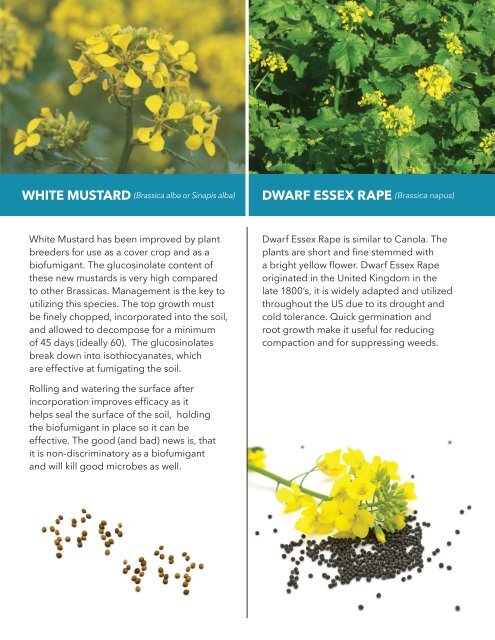Cover Crop Basics - Getting Started
An easy to understand Cover Crop Guide including information on understanding quality, seed cost, species information and best practices
An easy to understand Cover Crop Guide including information on understanding quality, seed cost, species information and best practices
Create successful ePaper yourself
Turn your PDF publications into a flip-book with our unique Google optimized e-Paper software.
WHITE MUSTARD (Brassica alba or Sinapis alba)<br />
DWARF ESSEX RAPE (Brassica napus)<br />
White Mustard has been improved by plant<br />
breeders for use as a cover crop and as a<br />
biofumigant. The glucosinolate content of<br />
these new mustards is very high compared<br />
to other Brassicas. Management is the key to<br />
utilizing this species. The top growth must<br />
be finely chopped, incorporated into the soil,<br />
and allowed to decompose for a minimum<br />
of 45 days (ideally 60). The glucosinolates<br />
break down into isothiocyanates, which<br />
are effective at fumigating the soil.<br />
Dwarf Essex Rape is similar to Canola. The<br />
plants are short and fine stemmed with<br />
a bright yellow flower. Dwarf Essex Rape<br />
originated in the United Kingdom in the<br />
late 1800’s, it is widely adapted and utilized<br />
throughout the US due to its drought and<br />
cold tolerance. Quick germination and<br />
root growth make it useful for reducing<br />
compaction and for suppressing weeds.<br />
Rolling and watering the surface after<br />
incorporation improves efficacy as it<br />
helps seal the surface of the soil, holding<br />
the biofumigant in place so it can be<br />
effective. The good (and bad) news is, that<br />
it is non-discriminatory as a biofumigant<br />
and will kill good microbes as well.



